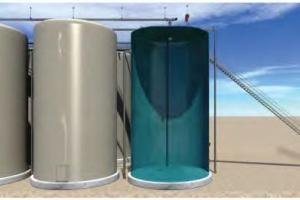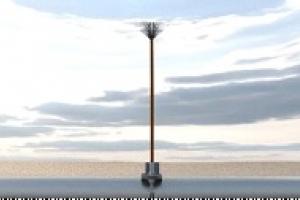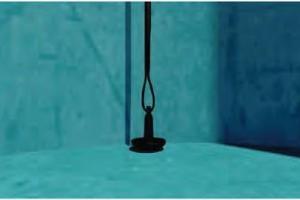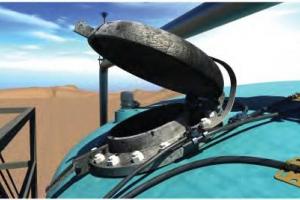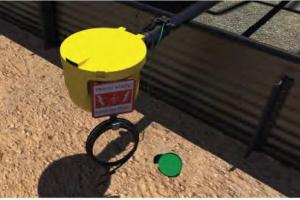Salt water disposal guidelines
.
Introduction
Each year tank batteries and other production equipment used in the oilfield are damaged due to lightning strikes and static electricity encounters. Salt water disposal (SWD) sites present a challenge due to tank battery exposures and the flammable fluids/vapors held within the tanks.
Holding tanks utilized with SWD’s include both metal and fiberglass tanks. Metal tanks, if sitting flat on the ground, are at times adequate for grounding dissipation; however, a qualified professional is needed to determine if ground moisture levels provide continuity.
Various tank manufactures have incorporated bonding/grounding materials within fiberglass tanks; yet this alone is not sufficient and additional bonding/grounding controls for static electricity are needed within tanks for storing/transferring large volumes of oilfield fluids.
Lightning protection
Aerial static dissipators
Preferred method of lightning protection. This design type involves structural static dissipators positioned above the tanks and along catwalks to control static electricity near/around the tank battery immediate area. Typically, lightning does not find this atmosphere attractive for a strike.
Catenary lightning protection
Accepted if properly installed and grounded. This lightning protection design “is old style” consisting of a bonded-grounded conductor rod mounted to the top of a pole, which is typically routed around the perimeter of the site being protected. The theory is if lightning were to hit, it would hit the lightning rod and dissipate through the ground system. Overhead bonding lines should be elevated high enough out of the tank’s vapor space per industry best practices.
Static control
Static lassos
Preferred method of static electricity protection. Installed within the interior of a tank, these lassos dissipate static electricity build up from within a tank holding oilfield fluids. As fluids move around within tanks, static electricity occurs and can be an ignition source for the vapor space. Static lassos should be properly bonded and grounded.
Thief hatches
Bonding wire/cable provided from lid to base and bonded back to properly grounded trunk line. Thief hatches are a vapor explosion hazard due to vapor presence and arc possibility; as the thief is located at the top of the tank along with potential flammable vapors. Thief hatch lids must be bonded/grounded as illustrated below.
Metal piping/valves/fitting
Metal objects extending from fiberglass tanks must be bonded and grounded.
Load out stations
Trucks/Trailers offloading oilfield fluids must be bonded to an adequate ground source.
Maintenance and inspection
Documented electrical bonding and grounding systems inspections should be completed every six months and include repairs or maintenance items needed and performed.
This material is provided for informational purposes only and does not provide any coverage or guarantee loss prevention. The examples in this material are provided as hypothetical and for illustration purposes only. The Hanover Insurance Company and its affiliates and subsidiaries (“The Hanover”) specifically disclaim any warranty or representation that acceptance of any recommendations contained herein will make any premises, or operation safe or in compliance with any law or regulation. By providing this information to you, The Hanover does not assume (and specifically disclaims) any duty, undertaking or responsibility to you. The decision to accept or implement any recommendation(s) or advice contained in this material must be made by you.
LC 2020-390
Related resources
Salt water disposal guidelines
.
Introduction
Each year tank batteries and other production equipment used in the oilfield are damaged due to lightning strikes and static electricity encounters. Salt water disposal (SWD) sites present a challenge due to tank battery exposures and the flammable fluids/vapors held within the tanks.
Holding tanks utilized with SWD’s include both metal and fiberglass tanks. Metal tanks, if sitting flat on the ground, are at times adequate for grounding dissipation; however, a qualified professional is needed to determine if ground moisture levels provide continuity.
Various tank manufactures have incorporated bonding/grounding materials within fiberglass tanks; yet this alone is not sufficient and additional bonding/grounding controls for static electricity are needed within tanks for storing/transferring large volumes of oilfield fluids.
Lightning protection
Aerial static dissipators
Preferred method of lightning protection. This design type involves structural static dissipators positioned above the tanks and along catwalks to control static electricity near/around the tank battery immediate area. Typically, lightning does not find this atmosphere attractive for a strike.
Catenary lightning protection
Accepted if properly installed and grounded. This lightning protection design “is old style” consisting of a bonded-grounded conductor rod mounted to the top of a pole, which is typically routed around the perimeter of the site being protected. The theory is if lightning were to hit, it would hit the lightning rod and dissipate through the ground system. Overhead bonding lines should be elevated high enough out of the tank’s vapor space per industry best practices.
Static control
Static lassos
Preferred method of static electricity protection. Installed within the interior of a tank, these lassos dissipate static electricity build up from within a tank holding oilfield fluids. As fluids move around within tanks, static electricity occurs and can be an ignition source for the vapor space. Static lassos should be properly bonded and grounded.
Thief hatches
Bonding wire/cable provided from lid to base and bonded back to properly grounded trunk line. Thief hatches are a vapor explosion hazard due to vapor presence and arc possibility; as the thief is located at the top of the tank along with potential flammable vapors. Thief hatch lids must be bonded/grounded as illustrated below.
Metal piping/valves/fitting
Metal objects extending from fiberglass tanks must be bonded and grounded.
Load out stations
Trucks/Trailers offloading oilfield fluids must be bonded to an adequate ground source.
Maintenance and inspection
Documented electrical bonding and grounding systems inspections should be completed every six months and include repairs or maintenance items needed and performed.
This material is provided for informational purposes only and does not provide any coverage or guarantee loss prevention. The examples in this material are provided as hypothetical and for illustration purposes only. The Hanover Insurance Company and its affiliates and subsidiaries (“The Hanover”) specifically disclaim any warranty or representation that acceptance of any recommendations contained herein will make any premises, or operation safe or in compliance with any law or regulation. By providing this information to you, The Hanover does not assume (and specifically disclaims) any duty, undertaking or responsibility to you. The decision to accept or implement any recommendation(s) or advice contained in this material must be made by you.
LC 2020-390
Related resources
Salt water disposal guidelines
.
Introduction
Each year tank batteries and other production equipment used in the oilfield are damaged due to lightning strikes and static electricity encounters. Salt water disposal (SWD) sites present a challenge due to tank battery exposures and the flammable fluids/vapors held within the tanks.
Holding tanks utilized with SWD’s include both metal and fiberglass tanks. Metal tanks, if sitting flat on the ground, are at times adequate for grounding dissipation; however, a qualified professional is needed to determine if ground moisture levels provide continuity.
Various tank manufactures have incorporated bonding/grounding materials within fiberglass tanks; yet this alone is not sufficient and additional bonding/grounding controls for static electricity are needed within tanks for storing/transferring large volumes of oilfield fluids.
Lightning protection
Aerial static dissipators
Preferred method of lightning protection. This design type involves structural static dissipators positioned above the tanks and along catwalks to control static electricity near/around the tank battery immediate area. Typically, lightning does not find this atmosphere attractive for a strike.
Catenary lightning protection
Accepted if properly installed and grounded. This lightning protection design “is old style” consisting of a bonded-grounded conductor rod mounted to the top of a pole, which is typically routed around the perimeter of the site being protected. The theory is if lightning were to hit, it would hit the lightning rod and dissipate through the ground system. Overhead bonding lines should be elevated high enough out of the tank’s vapor space per industry best practices.
Static control
Static lassos
Preferred method of static electricity protection. Installed within the interior of a tank, these lassos dissipate static electricity build up from within a tank holding oilfield fluids. As fluids move around within tanks, static electricity occurs and can be an ignition source for the vapor space. Static lassos should be properly bonded and grounded.
Thief hatches
Bonding wire/cable provided from lid to base and bonded back to properly grounded trunk line. Thief hatches are a vapor explosion hazard due to vapor presence and arc possibility; as the thief is located at the top of the tank along with potential flammable vapors. Thief hatch lids must be bonded/grounded as illustrated below.
Metal piping/valves/fitting
Metal objects extending from fiberglass tanks must be bonded and grounded.
Load out stations
Trucks/Trailers offloading oilfield fluids must be bonded to an adequate ground source.
Maintenance and inspection
Documented electrical bonding and grounding systems inspections should be completed every six months and include repairs or maintenance items needed and performed.
This material is provided for informational purposes only and does not provide any coverage or guarantee loss prevention. The examples in this material are provided as hypothetical and for illustration purposes only. The Hanover Insurance Company and its affiliates and subsidiaries (“The Hanover”) specifically disclaim any warranty or representation that acceptance of any recommendations contained herein will make any premises, or operation safe or in compliance with any law or regulation. By providing this information to you, The Hanover does not assume (and specifically disclaims) any duty, undertaking or responsibility to you. The decision to accept or implement any recommendation(s) or advice contained in this material must be made by you.
LC 2020-390
Related resources
Salt water disposal guidelines
.
Introduction
Each year tank batteries and other production equipment used in the oilfield are damaged due to lightning strikes and static electricity encounters. Salt water disposal (SWD) sites present a challenge due to tank battery exposures and the flammable fluids/vapors held within the tanks.
Holding tanks utilized with SWD’s include both metal and fiberglass tanks. Metal tanks, if sitting flat on the ground, are at times adequate for grounding dissipation; however, a qualified professional is needed to determine if ground moisture levels provide continuity.
Various tank manufactures have incorporated bonding/grounding materials within fiberglass tanks; yet this alone is not sufficient and additional bonding/grounding controls for static electricity are needed within tanks for storing/transferring large volumes of oilfield fluids.
Lightning protection
Aerial static dissipators
Preferred method of lightning protection. This design type involves structural static dissipators positioned above the tanks and along catwalks to control static electricity near/around the tank battery immediate area. Typically, lightning does not find this atmosphere attractive for a strike.
Catenary lightning protection
Accepted if properly installed and grounded. This lightning protection design “is old style” consisting of a bonded-grounded conductor rod mounted to the top of a pole, which is typically routed around the perimeter of the site being protected. The theory is if lightning were to hit, it would hit the lightning rod and dissipate through the ground system. Overhead bonding lines should be elevated high enough out of the tank’s vapor space per industry best practices.
Static control
Static lassos
Preferred method of static electricity protection. Installed within the interior of a tank, these lassos dissipate static electricity build up from within a tank holding oilfield fluids. As fluids move around within tanks, static electricity occurs and can be an ignition source for the vapor space. Static lassos should be properly bonded and grounded.
Thief hatches
Bonding wire/cable provided from lid to base and bonded back to properly grounded trunk line. Thief hatches are a vapor explosion hazard due to vapor presence and arc possibility; as the thief is located at the top of the tank along with potential flammable vapors. Thief hatch lids must be bonded/grounded as illustrated below.
Metal piping/valves/fitting
Metal objects extending from fiberglass tanks must be bonded and grounded.
Load out stations
Trucks/Trailers offloading oilfield fluids must be bonded to an adequate ground source.
Maintenance and inspection
Documented electrical bonding and grounding systems inspections should be completed every six months and include repairs or maintenance items needed and performed.
This material is provided for informational purposes only and does not provide any coverage or guarantee loss prevention. The examples in this material are provided as hypothetical and for illustration purposes only. The Hanover Insurance Company and its affiliates and subsidiaries (“The Hanover”) specifically disclaim any warranty or representation that acceptance of any recommendations contained herein will make any premises, or operation safe or in compliance with any law or regulation. By providing this information to you, The Hanover does not assume (and specifically disclaims) any duty, undertaking or responsibility to you. The decision to accept or implement any recommendation(s) or advice contained in this material must be made by you.
LC 2020-390



